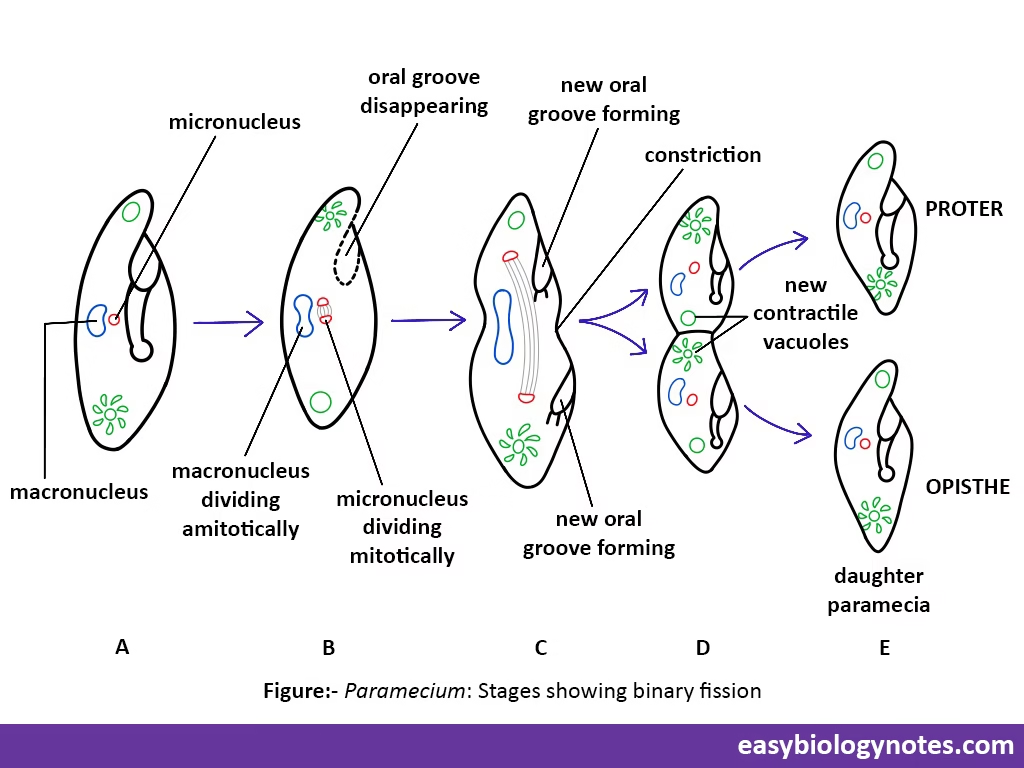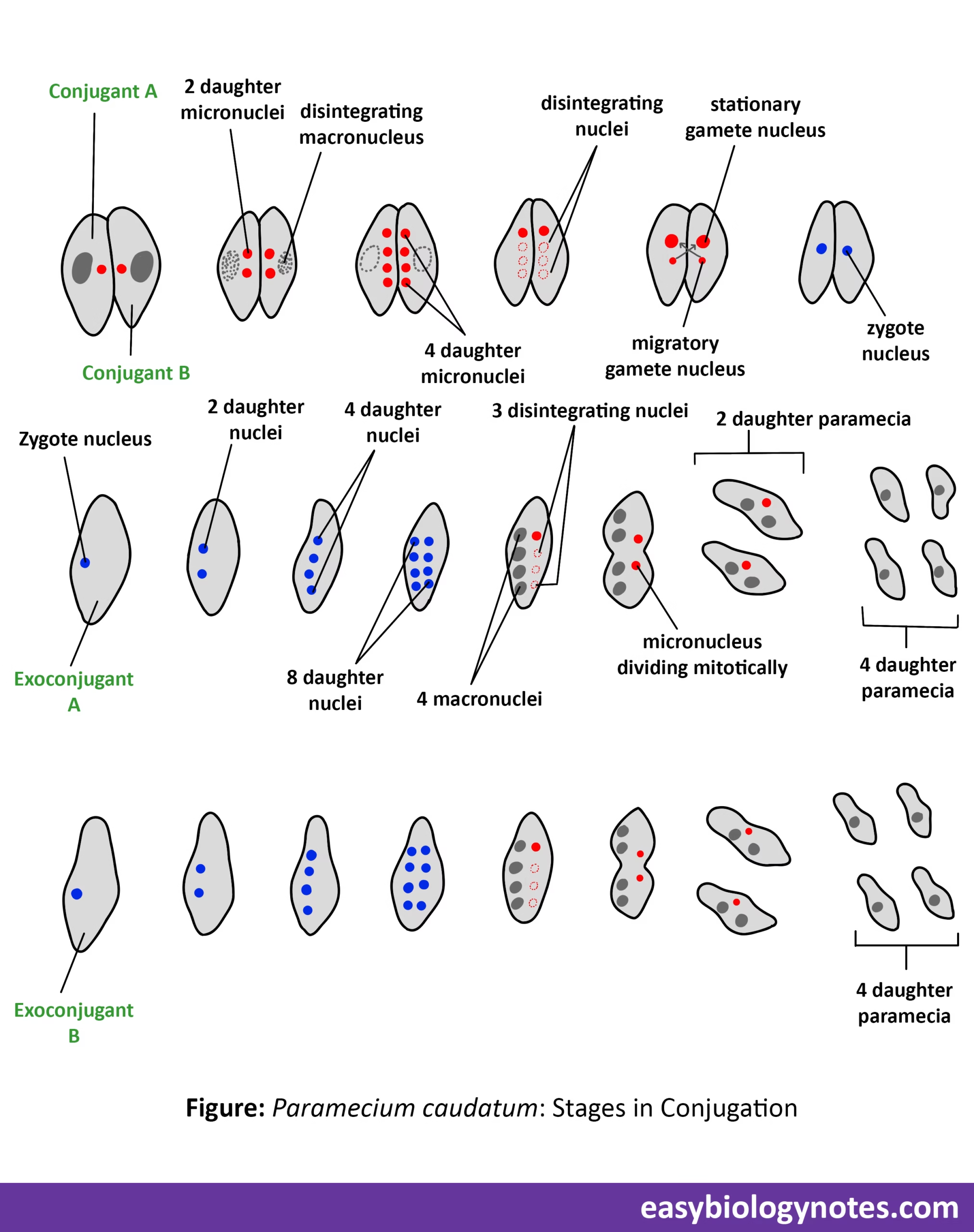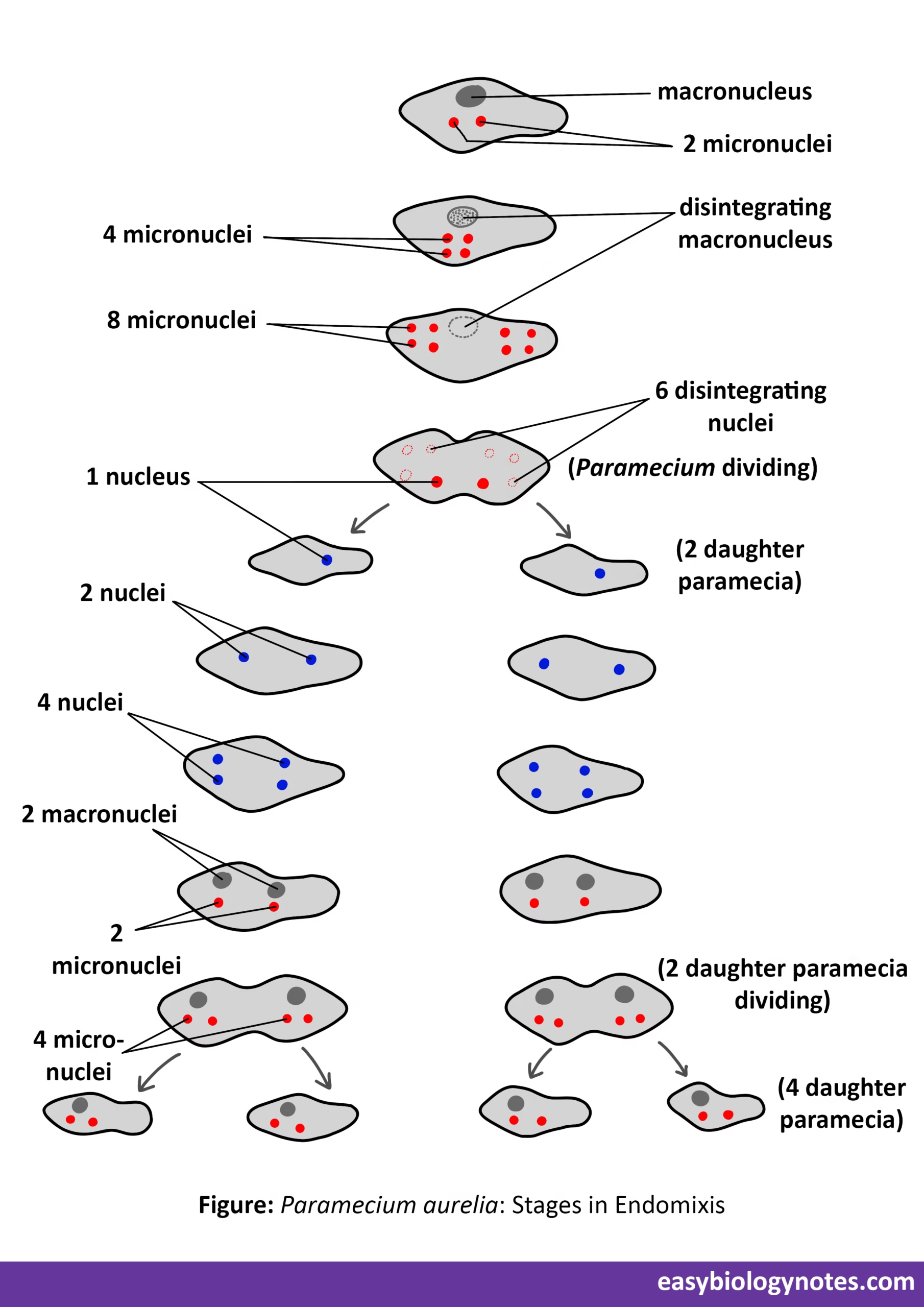Types of Reproduction in Paramecium
- Reproduction in Paramecium takes place asexually by transverse binary fission and also by several kinds of nuclear reorganizations, such as conjugation, endomixis, autogamy, e.t.c.
- Under certain conditions of food and temperature, it undergoes encystment.
Following are some common types of reproduction in Paramecium-:
[A] Reproduction in Paramecium by Transverse Binary Fission
- During favourable conditions, Paramecium commonly reproduces by transverse or horizontal binary fission, which is at right angles to the longitudinal axis of body.

- Paramecium stops feeding and its oral groove and buccal structures begin to disappear.
- While this is happening, the micronucleus starts dividing by the complicated process of mitosis, the nuclear membrane remaining intact.
- Micronucleus first increases slightly in size and then chromosomes, numbering from 36 to 150, depending upon the race, begin to appear.
- Each chromosome splits longitudinally to form two chromatids (prophase stage).
- Paired chromatids now get arranged on the nuclear spindle at its equatorial plane (metaphase stage).
- This is followed by the separation apart of chromatids and elongation of micronucleus (anaphase stage) and by the last stage (telophase stage), micronucleus becomes very much elongated and its two ends become organized into two daughter micronuclei when they gets separated.
- Simultaneously, the macronucleus divides amitotically by simply becoming elongated and constricted in the middle.
- Two oral grooves now begin to form, one in anterior half and the other in posterior half.
- Two original contractile vacuoles remain, one in each half of the dividing parent individual.
- Two new contractile vacuoles are later formed. Two new buccal structures also appear.
- In the meantime, a constriction furrow appears near the middle of the body. It deepens and ultimately the cytoplasm is completely divided, resulting into two daughter paramecia.
- Of the two daughter paramecia, the anterior one is called proter and the posterior is called opisthe.
These grow to full size and divide again by fission.
[B] Reproduction in Paramecium by Conjugation
- Paramecium undergoes a sexual phenomenon, which is called conjugation.
- It is frequently reffered to as sexual reproduction, but it is simply a temporary union of two individuals of same species for the purpose of exchanging a part of their micromolecular material.
- This remarkable process in Paramecium occurs frequently between binary fissions and is necessary for the continued vitality of the species.
Process of Conjugation
(details of this process differ slightly in different species of Paramecium. This is of Paramecium caudatum)
- In conjugation, two individuals or preconjugants, from two different mating types, come in contact ventrally and unite by their oral grooves.
- They stop feeding and their buccal structures disappear.
- The pellicle and ectoplasm degenerate at the point of contact and a protoplasmic bridge is formed between the two individuals which are now called the conjugants.
- While so united, like the ‘Siamese twins’, the conjugating pair continues to swim actively and a sequence of complicated nuclear changes takes place in each animal.
- The vegetative macronucleus simply breaks up into fragments, which are later absorbed by cytoplasm.
- The diploid micronucleus of each conjugant first grows in size and then divides by meiosis. Thus, 4 haploid daughter micronuclei are produced of which 3 degenerate or become pycnotic and disappear in each conjugant, while the remaining one divides by mitosis forming 2 unequal pronuclei or gamete nuclei.
- Smaller one is active migratory gamete nucleus and the bigger one is the passive stationary gamete nucleus.

- The migratory nucleus of one conjugant then passes through the protoplasmic bridge into the other individual and fuses with its stationary nucleus, forming a single diploid zygote nucleus or synkaryon.
- The two paramecia, after a union of about 12 to 48 hours, separate and are now called exoconjugants.
- In each exoconjugant, the zygote nucleus divides by mitosis three times in rapid succession producing 8 nuclei, of which 4 enlarge to become macronuclei and other 4 become micronuclei.
- Three micronuclei disgenerate and disappear, while the remaining micronucleus divides, with binary fission of exoconjugant.
- Thus, from each exoconjugant two daughter paramecia are obtained, each containing 2 macronuclei and one micronucleus.
- The micronucleus again divides with the division of each daughter Paramecium, forming two individuals each containing one macronucleus and one micronucleus.
- Thus, each conjugant produces four daughter individuals at the end of conjugation.
Factors and conditions of Conjugation
- Conjugation does not occur under favourable living conditions. Starvation or shortage of food and a particular bacterial diet or certain chemicals are said to induce conjugation in some species.
- The pairing conjugants are isogamous and there is no morphological sexual dimorphism into male and female conjugants.
- Conjugation never takes place among the members of a ‘pure line’, i.e., among the descendents of a single individual.
It occurs only between individuals belonging to two different mating types. Thus, a sort of physiologically sexual differentiation exists in Paramecium. - Clumping favours conjugation. It is the interaction of mating type substances (proteins) which are localized in cilia.
Significance of Conjugation
1. Nuclear reorganization: During conjugation the nuclear apparatus is reorganized and a readjustment occurs between it and the cytoplasm.
- Probably the macronucleus loses its potentialities in performing its multiple metabolic activities.
Its replacement by a new macronucleus brings renewed vigour and vitality to accelerate the metabolic activities.
2. Hereditary variation: During asexual reproduction by fission, the hereditary material of the parent passes unchanged on to the progeny, so that all the descendants of one Paramecium have the same inheritance.
- The periodic occurrence of conjugation, however, ensures inherited variation. It brings about the blending of two lines of ancestry just as bisexual reproduction does.
[C] Reproduction in Paramecium by Endomixis
- Endomixis (Gr., endon = within + mixis = mingling) is an interesting phenomenon involving a total internal nuclear reorganization within a single individual in a culture of pedigreed race of Paramecium, taking place in the absence of conjugation.
- It was first reported in the bimicronucleate species, Paramecium aurelia, occurring periodically at regular intervals of about 30 days.

- The vegetative macronucleus degenerates and disappears, while the micronuclei divide twice by mitosis forming 8 daughter nuclei of which 6 degenerate.
At this stage Paramecium also divides and each daughter paramecia receive one micronucleus. - This nicronucleus divides twice forming 4 nuclei, 2 of which become macronuclei and 2 micronuclei, in each individual.
- The micronuclei again divide with the binary fission of Paramecium into two daughters, each getting 1 macronucleus and 2 micronuclei.
- Thus, 4 daughters are produced from a single parent bringing about an intracellular nuclear reorganization and readjustment between the cytoplasm and the nuclear apparatus in each individual.
1 thought on “Reproduction in Paramecium”